HIDING FROM THE HIDE? EERIE DEEPSEA ENCOUNTERS WITH ABYSSAL ABOMINATIONS
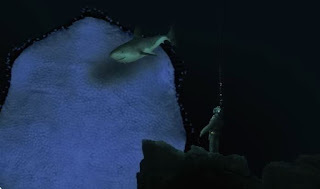 A photo-still from Encounter In The Abyss by RichardSvensson, depicting the nameless horror from the underwater abyss about toencapsulate the stricken shark while the terrified diver stood motionless, on aledge at the abyss's edge, watching in petrified fascination (© Richard Svensson)
A photo-still from Encounter In The Abyss by RichardSvensson, depicting the nameless horror from the underwater abyss about toencapsulate the stricken shark while the terrified diver stood motionless, on aledge at the abyss's edge, watching in petrified fascination (© Richard Svensson)Thedecidedly creepy cryptozoological report of a deadly underwater mystery beast documentedby me here today is one of my all-time personal favourites, which I've includedin several of my books and articles down through the years, and also previouslyon ShukerNature (click here). Now,thanks to a wonderful new animated short that brings the eerie encountervividly to life for the very first time (full details at the end of the presentblog article), I decided that it was time to revisit this terrifying denizen ofa deepwater abyss and provide some additional information, so here it is.
In1953, while testing a new type of deep-sea diving suit in the South Pacific, anAustralian diver named Christopher Loeb encountered a Lovecraftian horror fromthe ocean’s unpenetrated depths. In my book From Flying Toads To Snakes With Wings(1997) and also in my previous ShukerNature coverage of it, I provided amuch-abbreviated paraphrased version of Loeb's report, but here now is his fullfirst-person account, as originally provided by Eric Frank Russell in his own book GreatWorld Mysteries (1967:
All the way down I was followed by a fifteen foot shark whichcircled around full of curiosity but made no attempt to attack. I keptwondering how far down he would go. He was still hanging around some thirtyfeet from me, and about twenty feet higher, when I reached a ledge below whichwas a great, black chasm of enormous depth. It being dangerous to venturefarther, I stood looking into the chasm while the shark waited for my nextmove.
Suddenly the water became distinctly colder. While thetemperature continued to drop with surprising rapidity, I saw a black massrising from the darkness of the chasm. It floated upwards very slowly. As atlast light reached it I could see that it was of dull brown colour andtremendous size, a flat ragged edged thing about one acre in extent. Itpulsated sluggishly and I knew that it was alive despite its lack of visiblelimbs or eyes. Still pulsating, this frightful vision floated past my level, bywhich time the coldness had become most intense. The shark now hung completelymotionless, paralyzed either by cold or fear. While I watched fascinated, theenormous brown thing reached the shark, contacted him with its upper surface.The shark gave a convulsive shiver and was drawn unresisting into the substanceof the monster.
I stood perfectly still, not daring to move, while the brownthing sank back into the chasm as slowly as it had emerged. Darkness swallowedit and the water started to regain some warmth. God knows what this thing was,but I had no doubt that it had been born of the primeval slime countlessfathoms below.
Moreover,this may not be a unique report, for as revealed here by theonline Encyclopaedia of Cryptozoologywebsite:
According to Russian sources, at least two other sightings ofthe amorphous sea monster have been reported in local newspapers. Members of a Chileanhydrographic expedition to the South Pacific in 1968 told the press that theyhad seen an animal which resembled the Australian diver's "blackmass," near an abyssal trench. A fatal encounter with such an animalallegedly occurred off Thailand in 2005, when a French scuba diver named HenriAstor told the press that he had observed a very large "strange brownmass" paralysing and killing a shoal of fish. Astor's unnamed companionallegedly disappeared after attempting to follow the entity.
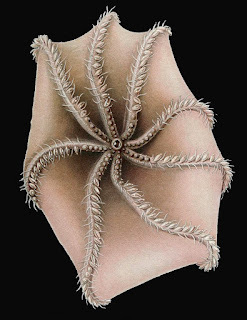 Cirrothauma murrayi
,
a species of deepsea cirrate octopus (public domain)
Cirrothauma murrayi
,
a species of deepsea cirrate octopus (public domain)
Inthe past, a deepsea octopus has been offered as a possible identity for thisdisturbing creature, but as I discussed in detail within my book, a far moresatisfactory candidate is a deepsea jellyfish, possibly akin to one of the knownrelatively shapeless types, such as Deepstariaenigmatica, which moves via peristalsis and lacks tentacles. This bizarrespecies remained undescribed by science until 1967, following its discovery by thefamous French oceanographer Jacques Cousteau while exploring the deep waters of the centralPacific Ocean near Southwest Baker Island in a submarine called Deepstar 4000. It is known from the Pacific Ocean,Antarctica, and the Gulf of Mexico, but only at depths below 3,000 ft.
Whereasall octopuses have tentacles, some deepsea jellyfishes do not. What they dohave, however, are potent stinging cells called nematocysts on their bodies(and tentacles if they possess any), armed with venom that swiftly paralysestheir prey. This would readily explain the immediate paralysis of the shark.Moreover, jellyfishes do not possess true eyes but they are equipped withsensory structures responsive to water movements. Consequently, the creaturewould have learnt of the shark’s presence by detecting its movements in thewater. How lucky, then, that the diver had remained stationary!
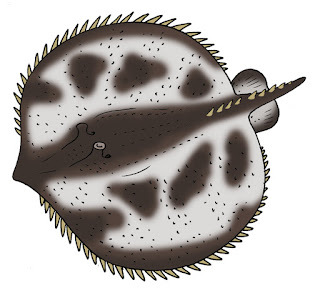 Artistic representation of el cuero, the deadly Chilean hide (© TimMorris)
Artistic representation of el cuero, the deadly Chilean hide (© TimMorris)
Interestingly,Chilean legends tell of a very similar beast called el cuero or the hide, as itis likened in shape and size to a cowhide stretched out flat, with countlesseyes around its perimeter, and four larger ones in the centre. As it happens,jellyfishes possess peripheral sensory organs called rhopalia that incorporatesimple light-sensitive eyespots or ocelli.
Moreover,some jellyfishes also have four larger, deceptively eye-like organs visible atthe centre of their bell. In reality, however, these organs are not eyes atall. Instead, they are actually portions of the jellyfishes' gut, known asgastric pouches, with the jellyfishes' horseshoe-shaped gonads sited directlyunderneath these pouches and also very visible (as in the familiar moonjellyfish Aurelia aurita).
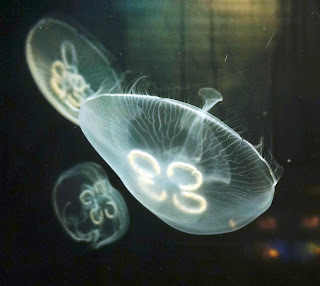 Moon jellyfishes Aurelia aurita(© Tila Monto/Wikipedia –
CC BY-SA 3.0 licence
)
Moon jellyfishes Aurelia aurita(© Tila Monto/Wikipedia –
CC BY-SA 3.0 licence
)
Soperhaps the deadly hide is more than a myth after all, lurking like so manyother maritime horrors reported down through the ages in the deep oceans'impenetrable black abyss, but only very rarely encountered by humankind – whichin view of the dreadful fate that befell the hapless South Pacific shark in1953 may be just as well!
And now, as noted above, this chillingcryptozoological vignette has been brought to vivid life by longstanding friendand awesome Swedish animator Richard Svensson, aka The Lone Animator, in awonderful 3-minute mini-movie entitled EncounterIn The Abyss, and available to watch for free on YouTube since 8 August2024 – just click here. Don't miss it!
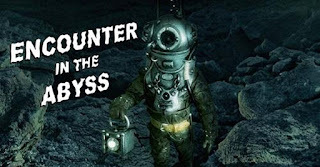 Thumbnailimage on YouTube for Encounter In TheAbyss by Richard Svensson (© Richard Svensson)
Thumbnailimage on YouTube for Encounter In TheAbyss by Richard Svensson (© Richard Svensson)
Karl Shuker's Blog
- Karl Shuker's profile
- 45 followers



